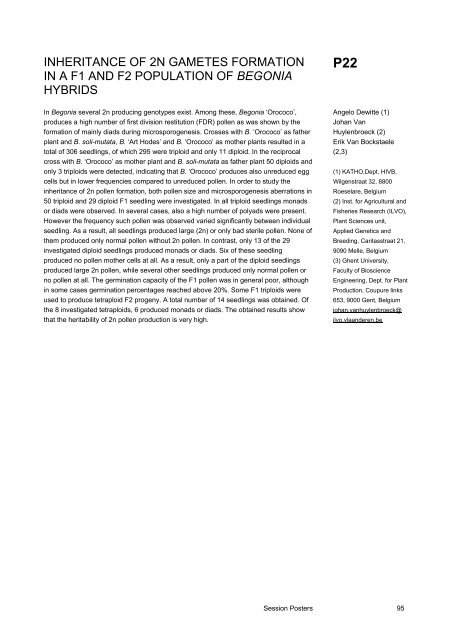XXIIIrd International Eucarpia symposium, Section Ornamentals ...
XXIIIrd International Eucarpia symposium, Section Ornamentals ...
XXIIIrd International Eucarpia symposium, Section Ornamentals ...
You also want an ePaper? Increase the reach of your titles
YUMPU automatically turns print PDFs into web optimized ePapers that Google loves.
INHERITANCE OF 2N GAMETES FORMATION<br />
IN A F1 AND F2 POPULATION OF BEGONIA<br />
HYBRIDS<br />
In Begonia several 2n producing genotypes exist. Among these, Begonia ‘Orococo’,<br />
produces a high number of first division restitution (FDR) pollen as was shown by the<br />
formation of mainly diads during microsporogenesis. Crosses with B. ‘Orococo’ as father<br />
plant and B. soli-mutata, B. ‘Art Hodes’ and B. ‘Orococo’ as mother plants resulted in a<br />
total of 306 seedlings, of which 295 were triploid and only 11 diploid. In the reciprocal<br />
cross with B. ‘Orococo’ as mother plant and B. soli-mutata as father plant 50 diploids and<br />
only 3 triploids were detected, indicating that B. ‘Orococo’ produces also unreduced egg<br />
cells but in lower frequencies compared to unreduced pollen. In order to study the<br />
inheritance of 2n pollen formation, both pollen size and microsporogenesis aberrations in<br />
50 triploid and 29 diploid F1 seedling were investigated. In all triploid seedlings monads<br />
or diads were observed. In several cases, also a high number of polyads were present.<br />
However the frequency such pollen was observed varied significantly between individual<br />
seedling. As a result, all seedlings produced large (2n) or only bad sterile pollen. None of<br />
them produced only normal pollen without 2n pollen. In contrast, only 13 of the 29<br />
investigated diploid seedlings produced monads or diads. Six of these seedling<br />
produced no pollen mother cells at all. As a result, only a part of the diploid seedlings<br />
produced large 2n pollen, while several other seedlings produced only normal pollen or<br />
no pollen at all. The germination capacity of the F1 pollen was in general poor, although<br />
in some cases germination percentages reached above 20%. Some F1 triploids were<br />
used to produce tetraploid F2 progeny. A total number of 14 seedlings was obtained. Of<br />
the 8 investigated tetraploids, 6 produced monads or diads. The obtained results show<br />
that the heritability of 2n pollen production is very high.<br />
P22<br />
Angelo Dewitte (1)<br />
Johan Van<br />
Huylenbroeck (2)<br />
Erik Van Bockstaele<br />
(2,3)<br />
(1) KATHO,Dept. HIVB,<br />
Wilgenstraat 32, 8800<br />
Roeselare, Belgium<br />
(2) Inst. for Agricultural and<br />
Fisheries Research (ILVO),<br />
Plant Sciences unit,<br />
Applied Genetics and<br />
Breeding, Caritasstraat 21,<br />
9090 Melle, Belgium<br />
(3) Ghent University,<br />
Faculty of Bioscience<br />
Engineering, Dept. for Plant<br />
Production, Coupure links<br />
653, 9000 Gent, Belgium<br />
johan.vanhuylenbroeck@<br />
ilvo.vlaanderen.be<br />
Session Posters 95














